
By Dr Md Aynal Haque
RAJSHAHI, Jan 11, 2024 (BSS) - Subsurface channels will produce 3.6 lakh tonnes of additional crops through bringing 45,000 hectares of lands under controlled irrigation in the region, including its vast Barind tract, within the near future.
To this end, 22.50 lakh meters subsurface irrigation channels will be installed in command areas of 4,500 deep tube-wells that will stop the conventional process of earthen channels together with wastage of irrigation water.
The promotional activities are being implemented on behalf of a project styled "Extension of Irrigation Area and Efficiency through Construction of Subsurface Irrigation Channel and Experimental Drip Irrigation System".
Barind Multipurpose Development Authority (BMDA) has been implementing the four-year project in 122 upazilas of all 16 districts in Rajshahi and Rangpur divisions since April 2022.
Main thrust of the Taka 329.014-crore project is to resist wastage of irrigation water through the best uses and controlling of irrigation water.
Project Director Shahidur Rahman told BSS that boosting crop production through enhancing command area of irrigation machineries together with well-controlling irrigation management is the allied objective of the project.
He said 4.5 lakh meters ribbon pipes will be installed in command areas of the 4,500 deep tube-wells for ensuring supplementary irrigation to various seasonal crops, including transplanted aman paddy and other less-irrigation consuming crops, to boost production of those.
BMDA, ever-largest irrigation-providing state-run entity in the country's northwest region, will produce 3.60 lakh tonnes of crops annually with the intervention of the project.
It will impart training to 4,000 grassroots farmers to reach the latest improved agricultural technologies and techniques on to the farmers with the ultimate goal of expanding ultramodern agricultural technologies.
BMDA Superintending Engineer Shahidur Rahman said subsurface channel is very much effective to resist at least 40 percent wastage of irrigation water side by side with elevating efficiency to 94 percent.
He said each of the ten deep tube-wells will provide irrigation to orchards of various high-valued fruits, including mango, guava, malta and papaya, on ten bigha of land in drip irrigation method under the project.
Time-fitting measures would be taken to make the farmers familiarized with water saving technologies, including drip irrigation, fertigation, Alternate Wetting and Drying (AWD) and alternate furrow irrigation in their farmlands.
Various forms of cost-effective irrigation technologies would be promoted to reduce the gradually mounting cost for irrigation besides boosting soil productivity.
Substantial and sustainable promotion of cost-effective irrigation can be the crucial means of mitigating the water crises in the region, particularly in the drought-prone area.
Upon its successful implementation by March 2026, the project will supplement the government's efforts to make the country self-reliant in food.
Mijanur Rahman, a grassroots farmer of Krishnapur village under Tanore Upazila in the district, termed the subsurface irrigation channels as blessings for them.
He clarified that the well-controlled irrigation system has proven means of saving irrigation water from wastages and farming land from losses.
Lauding the initiative of promoting subsurface irrigation channel Prof Chowdhury Sarwar Jahan said the project will contribute a lot towards resisting wastage of irrigation water to a greater extent.
He also called for promoting the less-water consuming crops like wheat, maize and pulses in Barind area to reduce the gradually mounting pressure on its underground water.
"Farming cost of the less-irrigation consuming cereal crops is less than the Irri-Boro paddy so utmost emphasis should be given on boosting the acreage of the crops," he said.
Prof Sarwar Jahan, who teaches at the Department of Geology and Mining at Rajshahi University, said the water-stressed condition of the Barind area can easily be mitigated through substantial and sustainable promoting the farming of Aush paddy, vegetables and various types of both conventional and non-conventional fruits including malta and dragon.
He urged the officials and researchers to put in their level best efforts to elevate the rice production to 5.32 tonnes per hectare per year by 2030 and collective efforts are needed to attain the cherished goal.
He said the role of the agriculture sector is very vital towards making the country's economy functional alongside ensuring food security.
Prof Chowdhury Sarwar Jahan mentioned that the government has attached highest priority to the agriculture sector and the field level officials and researchers should take the responsibilities of reaching the government's services to the farmers' doorsteps.